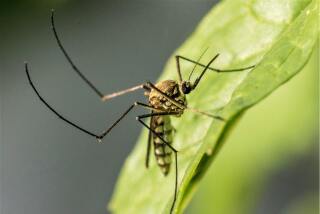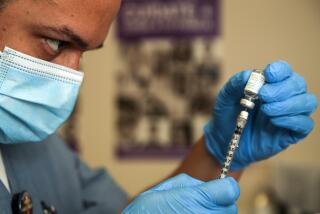New Syphilis Cases at All-Time Low
The number of new syphilis cases nationwide continued to fall in 2000, reaching an all-time low of 5,979 infections, federal health officials said Wednesday.
But several areas are seeing increased cases linked to outbreaks among gay men--a trend that a Los Angeles County public health official called “disturbing.”
Nationally, syphilis cases fell 9.6% last year, the Centers for Disease Control and Prevention said. The figure is down 30% since 1997 and nearly 90% since the epidemic’s last peak in 1990.
More than half of all syphilis cases last year were concentrated in 22 counties and cities. The figures cover cases of primary syphilis, which causes a painless sore, and secondary syphilis, which usually creates a rash.
“This dramatic reduction suggests a unique opportunity to eliminate syphilis in this country,” said Dr. Ronald O. Valdiserri, deputy director of CDC’s National Center for HIV, STD and TB Prevention. “However, unless we sustain action to eliminate syphilis, we could once again experience a rise in syphilis rates.”
The CDC’s goal is to reduce infectious syphilis cases to 1,000 or fewer each year and to rid syphilis from at least 90% of U.S. counties by 2005. Last year, about 80% of counties reported no cases.
Los Angeles County ranked ninth highest in the nation, with 152 infections last year. But given its size, the county’s infection rate (the number of cases per 100,000 residents) was below the national average.
California reported 326 cases last year, according to the Department of Health Services. That was up from 284 in 1999.
The problem is far greater in the southeastern region of the country.
CDC officials attributed their success to targeting low-income black communities, which are disproportionately affected by the disease. Infections are 21 times more common in blacks than whites.
Federal officials have also slashed the number of congenital syphilis cases in newborns by 50% since 1997.
Syphilis is a sexually transmitted disease that can cause cardiovascular and neurological diseases if left untreated. Syphilis causes genital ulcers, which can accelerate the spread of HIV at least two- to five-fold. Untreated syphilis during pregnancy can result in infant deaths in up to 40% of cases.
While syphilis remains primarily a heterosexual disease, evidence suggests that it is becoming more common among gay males. Men developed 50% more infections than women in 2000, a stark increase from 1994 when the two sexes had comparable infection rates. In addition, since 1999, the CDC has identified outbreaks among gay men in Los Angeles, Chicago, New York, Seattle and Miami Beach.
“These outbreaks coincide with other evidence of increases in sexual risk behavior among some populations of men who have sex with men,” said Dr. George Counts, director of CDC’s syphilis elimination program.
The problem in Los Angeles County appears to be getting worse. Through Oct. 12 of this year, the county logged 135 cases of syphilis, compared with 105 in the same period last year. More than 55% of the cases are in men who have sex with other men.
“The numbers seem to be creeping up,” said Dr. Robert Settlage, medical director of the county’s sexually transmitted disease program. “It’s not growing explosively, but the steadiness of it is disturbing.”
At CDC pilot prevention sites in Nashville, Indianapolis and Raleigh, N.C., cases were down more than 20% in 2000 because of education campaigns, screening and treatment of jailed prisoners, and free testing at clinics and libraries.
Eliminating syphilis would decrease “one of the most glaring racial disparities in health care today,” Valdiserri said.
Public health officials in the United States, acknowledging they must devise new programs to target gay men, will release suggested prevention and treatment approaches for that group early next year.
“It brings us back to the drawing board,” Settlage said. “If we can harness the kind of energy and passion and creativity that organized gays in California put together to get attention to HIV, then we may be onto something that may help us to control syphilis.”
More to Read
Sign up for Essential California
The most important California stories and recommendations in your inbox every morning.
You may occasionally receive promotional content from the Los Angeles Times.










